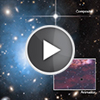CXC Home | Search | Help | Image Use Policy | Latest Images | Privacy | Accessibility | Glossary | Q&A
Tour of Abell 1795
Quicktime MPEG
A star that wanders too close to a supermassive black hole is doomed, as it should be ripped apart by extreme tidal forces. The debris from the star is expected to fall towards the black hole, getting hotter and producing intense X-rays. The X-rays should then fade as the hot gas spirals inward. Using Chandra, this behavior may have been spotted, for the first time, in a dwarf galaxy. Bright X-rays from the location of this small galaxy were seen in 1999 until they faded and eventually disappeared in 2005. In the past few years, Chandra and other astronomical satellites have identified several suspected cases of a supermassive black hole ripping apart a nearby star. This newly discovered episode is different because it has been associated with a much smaller galaxy than these other cases. The black hole responsible for the destruction may be only a few hundred thousand times as massive as the Sun, making it ten times less massive than the Galaxy's supermassive black hole. Astronomers believe that black holes of this size may be the "seeds" that ultimately formed the supermassive black holes in the centers of galaxies like the Milky Way.
[Runtime: 01:20]
Quicktime MPEG
A star that wanders too close to a supermassive black hole is doomed, as it should be ripped apart by extreme tidal forces. The debris from the star is expected to fall towards the black hole, getting hotter and producing intense X-rays. The X-rays should then fade as the hot gas spirals inward. Using Chandra, this behavior may have been spotted, for the first time, in a dwarf galaxy. Bright X-rays from the location of this small galaxy were seen in 1999 until they faded and eventually disappeared in 2005. In the past few years, Chandra and other astronomical satellites have identified several suspected cases of a supermassive black hole ripping apart a nearby star. This newly discovered episode is different because it has been associated with a much smaller galaxy than these other cases. The black hole responsible for the destruction may be only a few hundred thousand times as massive as the Sun, making it ten times less massive than the Galaxy's supermassive black hole. Astronomers believe that black holes of this size may be the "seeds" that ultimately formed the supermassive black holes in the centers of galaxies like the Milky Way.
[Runtime: 01:20]
(Credit: NASA/CXC/A. Hobart)
Return to Abell 1795 (January 8, 2014)



